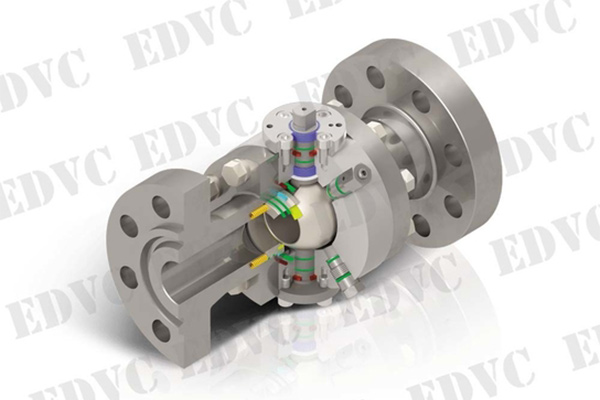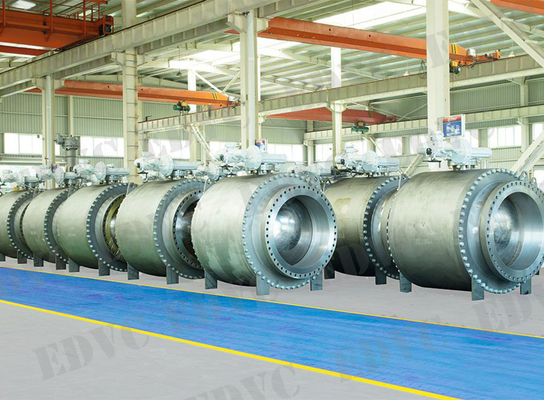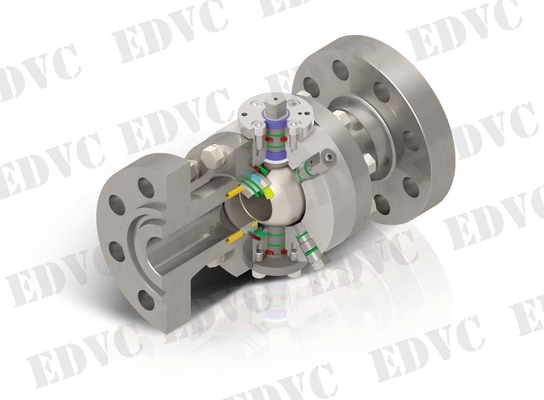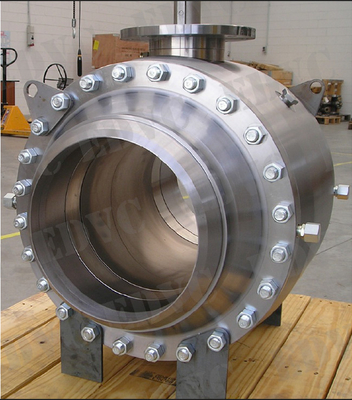GALLERY
PRODUCT DESCRIPTION
3 Pices Forged Steel Side Entry Ball Valve
Trunnion mounted ball valves are based on a system that provide a fixed ball and floating seat rings, moving along the valve axis.
The side load given by the pressure acting on the ball is absorbed by the bearings. At low pressure, the sealing on the seats is obtained by the spring action on the seat rings. The more the pressure increases, the more it pushes the seats against the ball.
the trunnion mounted valves are available from ½” to 36” – ASME class 150 to 2500 – as well as API 6A 5000 and 15.000 – in several combinations of materials and execution to cover all possible service application from low temperature to high pressure
Design Features & Applications
EDVC’s standard ball valves have been designed to API’s highest standards. Complete Split body & Fully welded design offers maximum protection against line pressure and thermal distortion with long life and trouble-free performance.
EDVC is supplying its products to the Crude oil transport and processing, Power engineering, Water supply systems and Process Industries throughout the world.
Seal Feature
EDVC ball valves are produced with spring-loaded seats. This spring load keeps the seat in contact with the ball even in absence of line pressure and makes very efficient seal at low line pressure.As line pressure increases, the seat area creates a piston effect which forces the seat against the ball, therefore a tight seal becomes effective. If the pressure is higher, the force exerted by the seat on the ball is increased by action of the pipeline pressure. Therefore, the higher the line pressure, the greater the piston action.
Self Lubrication
Self lubrication, low friction PTFE is used for trunnion and stem bearings. NYLON or other low friction materials are used for seat inserts. Self lubricating seals and stem bearing give predictable operating torque for the life of the valve.
Fire Safe Construction with Secondary Metal Seat
EDVC’s ball valves have been fire tested and can be supplied to API 6FA and API 607. The soft seat inserts, irrespective of their materials, will possibly fail when subjected to sudden high temperature conditions. EDVC provides a fire-safe design which may substantially prevent leakages through seals when damaged by high temperature. The function of the seats before and after the fire test is shown on the sketches. If the seat inserts are destroyed or burned out, a metal to metal seal is formed between the lower diameter of the seat and ball, while the seat to body seals, the stem packing and the end connections to body seals are designed to resist high temperature and will remain undamaged.

(Figures 1 & 2)
Trunnion Mounting
Trunnion mounted stems absorb the thrust from line pressure, preventing excess friction between the ball and seats, so even at full rated working pressure, operating torque stays low.

(Figure 3)
Body Vent and Drain
The body cavity may be vented in both open and closed state.

(Figure 4)
Double Block and Bleed
The seats are of both-side-sealing type, which means that they seal both on the upstream or downstream side of the ball valve and inside the valve. Whether in the open or closed position, pressure on each side of the ball is blocked from the body cavity by the seat rings engineered to self relieve. No pressure build up can occur in to body cavity. The body cavity can then be vented to the atmosphere or drained through the body port.

(Figure 5)
Sealant Fitting
Sealant lubrication fittings come as a standard with EDVC’s design. In the event of seat insert or stem seal damage, external or internal leakage can occur. Emergency sealant injection can save the integrity of the valve by incorporating a sealant seal around the stem or between the seat and the ball until such time the valve may be properly serviced.

(Figures 6, 7 & 8)
Antistatic Device
The springs provided at the stem allow the static charges to be led to the piping. In this way, an electrostatic charging of the ball is eliminated.

(Figure 9)
3-Piece Trunnion Ball Valves - Full & Reduced Port Expanded View

no | name of Part | Materials | |
1 | Body | A350 LF2 | A182 F316 |
2 | Closure | A350 LF2 | A182 F316, A351, CF8M |
3 | Stem | A350 LF2+ENP | 316 SS, 17-4 PHSS, 410 SS |
4 | Seat Ring | A350 LF2+ENP | 316 SS, 410 SS |
5 | Ball | A350 LF2+ENP | A182F316, A351, CF8M, 410 SS |
6 | Seat Insert | Devlon, Nylon, PEEK, RTFE | |
7 | Trunnion | A350 LF2 | 316 SS, 410 SS |
7-1 | Trunnion Block | A350 LF2 | 316 SS, 410 SS |
7-2 | Trunnion Block Pin | 410 SS | 316 SS, 410 SS |
8 | Gland | A350 LF2 | 316 SS, 410 SS |
9 | Adapter Plate | A350 LF2 | 316 SS, 410 SS |
10 | Stem O-ring/ Lipseal | Low Temp HNBR /Viton AED | |
11 | Stem O-ring | Low Temp HNBR /Viton AED | |
12 | Gland O-ring | Low Temp HNBR /Viton AED | |
13 | Seat O-ring/Lipseal | Low Temp HNBR /Viton AED | |
14 | Seat Subseal | Low Temp HNBR /Viton AED | |
15 | Closure O-ring | Low Temp HNBR /Viton AED | |
16 | Trunnion O-ring | Low Temp HNBR /Viton AED | |
17 | Backup Ring | PTFE | |
18 | Gland Seal | Low Temp HNBR /Viton AED | |
19 | Body Seal | Low Temp HNBR /Viton AED | |
20 | Trunnion Seal | Low Temp HNBR /Viton AED | |
21 | Stem Packing | Graphite | |
22 | Seat Spring | Inconel X-750 | |
23 | Bearing | PTFE, Carbon Steel | PTFE, 316SS |
24 | Thrust Washer | PTFE, Carbon Steel | PTFE, 316SS |
25 | Sealant Fitting | Carbon Steel, SS Ball Check | 316SS, SS Ball Check |
26 | Socket Bolt | A320 L7M | A193 B8/B8M |
27 | Socket Cap Screw | A320 L7M | A193 B8/B8M |
28 | Stud Bolt | A320 L7M | A193 B8 |
29 | Hex Nut | A194 7M | A194 8 |
30 | Grounding Pin | Stainless Steel | |
31 | Grounding Spring | Inconel X-750 | |
32 | Key | Carbon Steel | Stainless Steel |
33 | Dowel Pin | Carbon Steel | Stainless Steel |
34 | Relief Plug | Carbon Steel | Stainless Steel |
35 | Drain Plug | Carbon Steel | Stainless Steel |
36 | Mounting Plate | Carbon Steel | Stainless Steel |
37 | Gear Operator | Ductile Iron Case, Carbon Steel Worm Gear | |
38 | Hand Wheel | Carbon Steel, Ductile Iron | |
note: Materials also available in F321, F347, F51, F53, monel, inconel, incolloy and hastelloy. Metal-to-metal seated ball valve designs are available upon request. | |||
note: Additional materials available upon request.
*= Used only in bolted body construction.





Leave your message